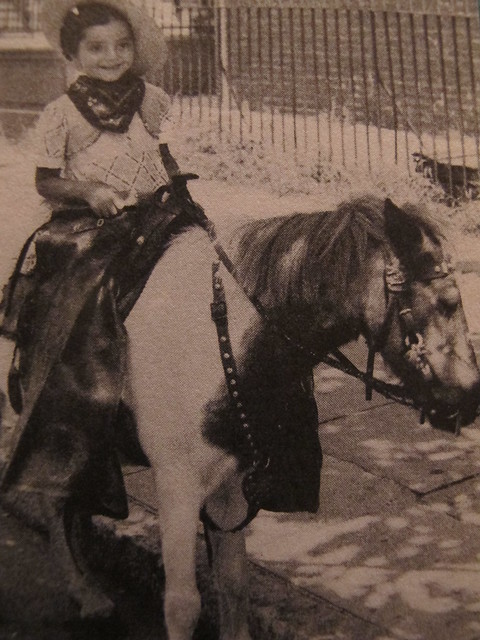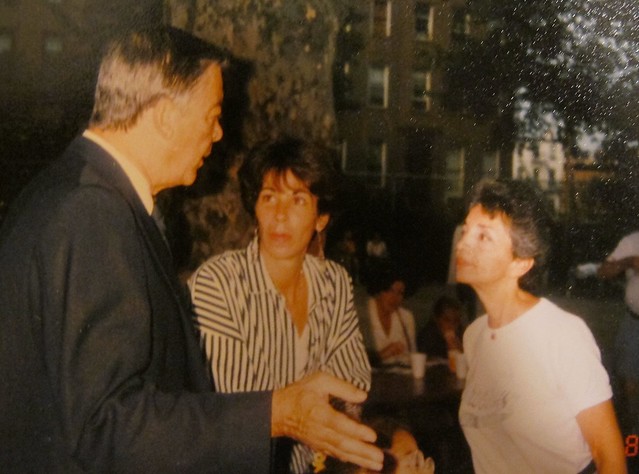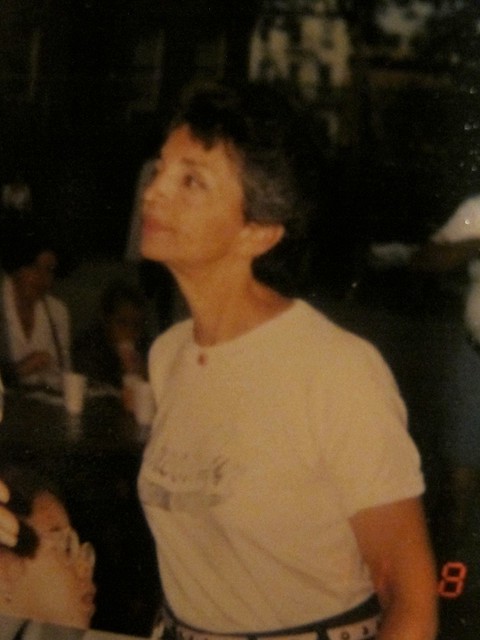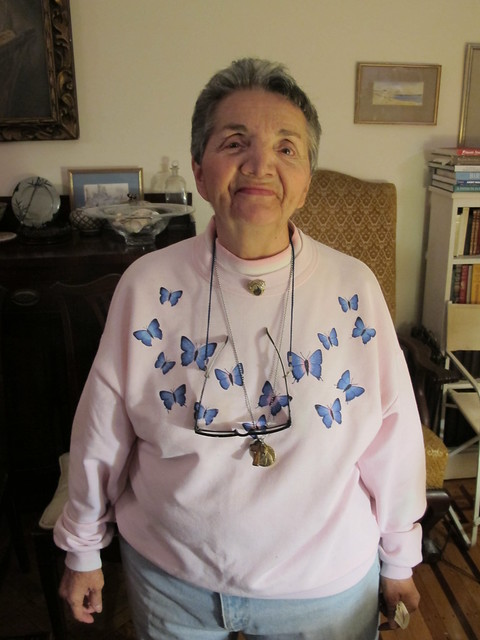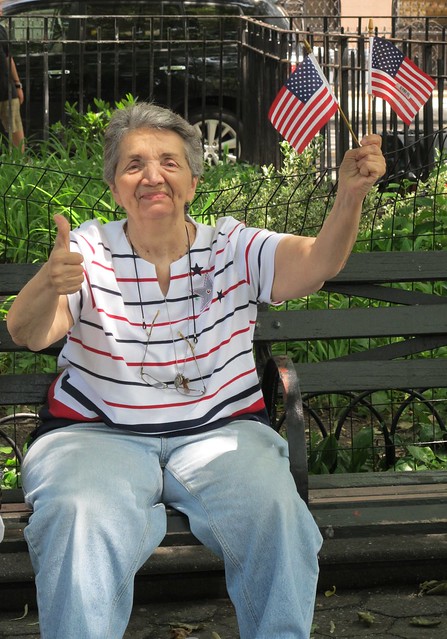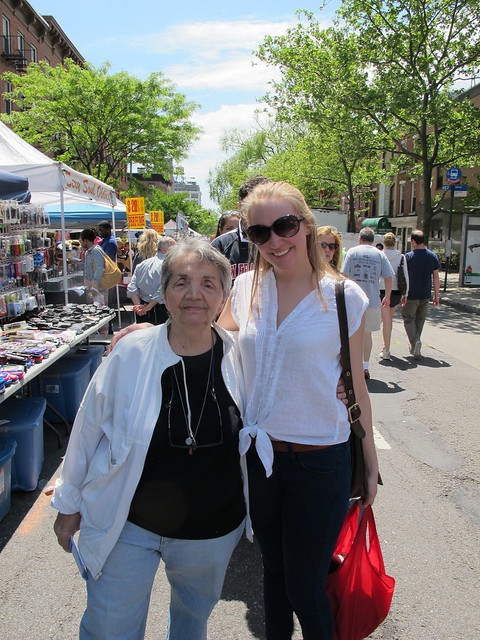Celia Cacace as a Child in Red Hook
(Cacace family photo)
Celia Cacace (on the right) with former Brooklyn Borough President Howard Golden (on left) at the Carroll Park re-opening ceremony in the 1980's
Celia at Community Board 6's Christmas Party in 2011
Celia in October 2012
At the Veterans Day Celebration in Carroll Park
Celia Cacace with my daughter C. at the Court street Fair, May 2012
As many of you know, Celia Maniero Cacace, a life long resident of Red Hook/ South Brooklyn, has to move away from the neighborhood she loves passionately. Not only will she be missed by all who had the good fortune to make her acquaintance, but the neighborhood is losing a very special person and community advocate. Saddest of all, Celia's knowledge of the history of the neighborhood will l
eave with her.
Many of us who love her are planning a farewell party for her on Sunday, January 13th. Please do come in and say good-bye to Celia.
Celia Cacace Tribute Party
Sunday January 1/13/13
3:30pm to 6:30pm
Mama Maria's Restaurant
307 Court StreetBrooklyn, NY 11231
Below is a lovely biography on Celia by her friend Carolina Salguera, founder and director of PortSide NewYork,
Celia Maniero Cacace
Fearless, feisty, loving and frank A champion of our community's weaker members
by Carolina Salguera
Celia Maniero Cacace is the mother and walking memory of the neighborhood she still calls South Brooklyn Red Hook; that's Carroll Gardens, Columbia Waterfront District and Red Hook for those of you got here after the 1960's.
To walk Court Street with the diminutive, doting Celia is to feel in the presence of a community Mayor. She's stopped every few feet or hailed from across the street by seniors or children to share news or advice.
Having served as a one-woman social service agency for decades, 77-year old Celia is now in need of some help herself. She is obliged to move from her apartment since the building is being sold, and she needs to find that rare, inexpensive place in a neighborhood where prices have soared beyond the fixed incomes of seniors. Know someone who wants a granny au pair, or granny doorman? A committee is forming to help her find a place; and if need be, help launch some fundraising to cover the gap between her fixed income and the rent. She moves out of her current place on January 14 to her son's in Wisconsin.
We are organizing a send off party for Celia and a campaign to bring her back. That kicks off Sunday January 1/13/13. (Details at bottom) Everyone is invited. Please bring a memory of Celia if you can.
Celia's life and prodigious memory describe a time when people stayed in a neighborhood—Celia has lived her whole life in 8 apartments within a 10 block radius— and when this area was largely Italian, as far back as when Italians still faced discrimination as the new immigrants.
Even today, Celia's back straightens as she says, "my older sister Jennie was one of the first Italian-Americans to knock down the walls on Wall Street. She was an amazing mathematician."
Celia is the 8th child of nine, of parents from the Island of Ischia in Italy. Her mother worked as a governess in France before emmigrating to the United States. With pride, Celia says her mother gave birth to her last child at 51. The family was displaced from 107 Rapelye Street for the construction of the BQE, an early experience with public works which might be what sharpened Celia's ability to analyze land use issues.
Tomboy Celia broke her nose and ran with the boys until she was married in 1960 to the boy next door Joseph Cacace.
She had two sons, Gregory and Robert, and was widowed early in 1979.
Over the years, Celia's community service had formal and informal components.
She served for more than twenty years as an active member of Community Board 6, on the Housing, Human Services, Economic development, Land Use, Landmark, Transportation, and City Properties Committees. Celia has been recognized for her perfect attendance at CB6 meetings, which demonstrated her serious purpose and commitment to her appointment to the Community Board. Aside from keeping meticulous meeting notes in her famous black and white copy books in multiple color inks, Celia is also remembered for her "compound questions", as City Council member Brad Lander has noted.
Celia's role in CB6 and other public meetings was often the voice speaking truth to power. Her private good works took the form of tending to the community's weaker members without fanfare or public acknowledgement.
That work followed the rhythms of the pre-blog, air conditioning and play date era when life was lived and information exchanged on the stoop and playgrounds, in street festivals and over laundry lines strung behind the brownstones. Someone needing help would be told "go see Celia."
Her helping likely began, she's not keeping track, with coordinating summer jobs for youth of Italian American Club of South Brooklyn which had her run clean up crews for the annual Feast of Our Lady of Sorrow. That Feast began around 1945 and ran from Kane to Summit Street. Celia joined the tradition in the 1960s, and worked it until its waning years on Court Street in the 1980s. She found work for youth, and for adults, in the booths, worked with Sanitation to keep the feast site clean and well run and prevented fights between the teens.
Over the decades, she would get summer jobs for teens. She was firm about the rules. "You gotta get your parents to talk to me, kid", to make sure they approved, "faccia a faccia" ("face to face" in Italian). All her serious business is done faccia a faccia; forget the phone.
During the 70s and early 80s, she organized festivals in Carroll Park with clowns, concerts and DJs. Ever inclusive, she arranged for teens to have DJ time, and insisted they play some of everyone's music, Italian, Puerto Rican, rock n roll and oldies. She also allowed teens to DJ before the feast and procession, cannily roping in and managing the younger generation.
"If they blasted the music, they had to account to me since I was the person speaking for them. I had a nice rapport, I never pointed my finger at them. If I had to talk to someone, I would walk them down the block and talked to them privately. If you talk to them in front of the other kids, then they would rank them out."
Celia also helped reactivate the original Society of Mother Cabrini of South Brooklyn, their feast and procession. Celia has that rare combination of deep pride in her identity (a layering of family, ethnicity, neighborhood) and the ability to simultaneously support others affirming their own, plus the smarts to understand that everyone needs to be included for a community to work.
Ever the intermediary between groups, she facilitated special events like the 100th anniversary for the Norwegian Seaman's Church (now condos), coordinating between the Scandinavians, the Italians and the police; and helped arrange donations for many churches not her own.
By the 1990s, she was ensconced at a desk at Postal Press on Court Street, where I first spotted her when I went in for photo copies. Her small head would pop up from behind a desk piled high with clippings from local papers. I observed a steady stream of people coming in to have hushed consultations over the counter with her: problems with bad landlords, unfair evictions, seniors who didn't understand their meds and had Celia be a liaison with the pharmacist, older Italians needing translation help, teens looking for jobs, people who needed help with city permits or were stymied by bureaucracy, or were just overwhelmed for whatever reason.
By the 2000's, I would catch up with Celia at Joe's Restaurant on Court Street, where she spent hours every morning cutting clippings from local papers and serving as on-the-spot greeter, advisor and nanny. Many a weekend morning, I saw young parents come in for brunch and sit frazzled by their children. Celia would step in with toys she bought on sale or at stoop sales and then boiled and bleached at home. I could see parents relax and see them find time for one another as the tikes' action was transferred to Celia.
Celia's beef with the term "Carroll Gardens" is that she remembers the slight to her pride.
This area was once redlined, her own family could not get a loan; and real estate brokers and other activists invented the term in the 60's to help market the brownstone area and delineate it from what is now called Red Hook "across the tracks" of the BQE. Rather than rebranding where she lived and pulling away from others, Celia preferred to help get jobs for people from "the Hook" and to wear a t-shirt "I live in South Brooklyn Red Hook not Carroll Gardens and I'm proud of it." It's a "love us for who we are, not who you want us to be" approach. She delivers a lot of love on the ground.
Several years back, I and Allison Prete, the director of the documentary film about the Gowanus Canal "Lavendar Lake" agreed that someone should make a documentary about Celia Cacace. Her stories, meeting notes and clippings are legion. As her apartment is being packed up, some 40 bankers' boxes have already been transferred to an archivist, journalist and local historian.
Celia Cacace is mother and memory of this community which needs her as much as she needs to be here. We are organizing a Tibute to Celia party for her and a campaign to bring her back. That kicks off Sunday January 1/13/13. Everyone is invited. Please bring a memory of Celia if you can.
Did Celia Cacace live in your house? Local addresses of Celia Cacace.Tickets are $30 ($10 for seniorsy. To RSVP for the event, call Community Board 6 at 718-643-3027
107 Rapelye Street 288 Van Brunt Street 28 First Place 64 Third Place 252 President Street 271 Union Street 285 President Street 83 First Place.

